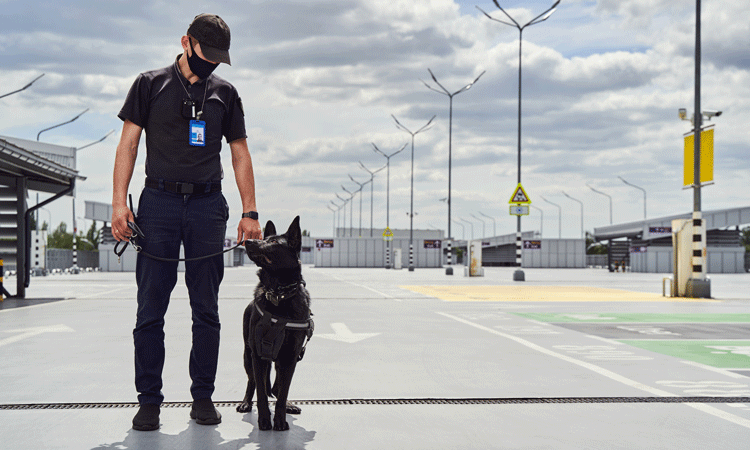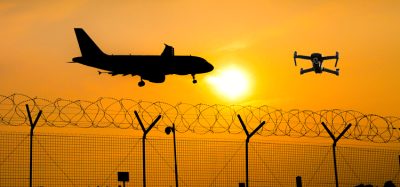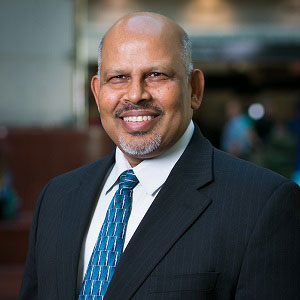Innovating for today’s airport security threats
Posted: 21 October 2025 | Holly Miles | No comments yet
In part two of this article series, Holly Miles looks at how the airport industry is leveraging new technologies to promote security and lessons learned from recent high profile security incidents.


In part 1 of this article we explored recent high-profile security incidents at airports around the world, how they happened, and what it says about the airport security landscape today.
Despite a few high-profile security incidents in recent years mentioned in part 1 of this article, it should be noted that aviation is still incredibly safe for passengers and staff. However, incidents such as those highlighted in the previous article do highlight an evolving threat landscape for airports. Thankfully, the security sector is constantly developing new technologies to automate detection, reduce human error and improve safety, which we will explore in this article.
However, you cannot embrace the benefits of technology without owning the risks, and those in leadership must understand and actively manage this balance. Speaking exclusively to International Airport Review, Neville Hey, Head of Aviation Security Advisory, Strategy, Partnerships and Director of Training for INTERPORTPOLICE, said: “Technology is embedded in all our lives. But the tech comes with its own problems: cyber threats, industrial espionage, satellite interference, and the perennial favourite—regulatory headaches. Senior executives pondering over AI policies or simply not understanding the need.”
Next generation security scanners
Airports such as London Gatwick have implemented new computed tomography (CT) scanners. CT scanners are traditionally used in the medical sector and can create 3D X-ray images so that baggage can be inspected from multiple angles. With the integration of artificial intelligence, prohibited items in luggage can be automatically detected. The European Union mandated the rollout of this technology in EU airports by 2026, while the TSA has plans to deploy these scanners across major airports in the near future.
In March 2023, Frankfurt Airport impressively became the first in the world to implement walk-through security scanners as a standard part of security checks. The millimetre-wave technology used in the scanners penetrate clothing, while an avatar pinpoints potentially dangerous objects in real time. If an alarm is triggered, security personnel can focus on the specific indicated area instead of having to completely rescan the passenger.
Biometric roll-out
Biometric technology has made headway within airports in recent years by streamlining identity verification through facial recognition, fingerprint scanning and iris recognition. While airports are now leaning more heavily towards contactless biometric identity confirmation, this improves security by providing more reliable identity verification compared to traditional documents such as passports. Biometric traits such as facial features, fingerprints and iris patterns are completely unique to each individual and are difficult or impossible to steal or forge. Biometrics reduces identity fraud and allows authorities to cross-check individuals against watchlists and databases for flagged individuals. By automating identity checks it minimises human error and frees up security staff to focus on the type of security intelligence that humans are best at.
That said, the rise and evolution of extremely convincing deepfake technologies is said to pose ‘a severe threat to traditional authentication systems that rely on visual or auditory cues for verification’, according to a new report from the California-based Institute for Security and Technology (IST). The report underlines that biometric systems that use facial or voice recognition have already been compromised by deepfake technology in several cases. However, most modern biometric systems use liveness detection, which can determine whether the source is live and whether they are a real person or a fake representation. Despite this technology, it is still not impossible to spoof these systems due to the advancement of deepfakes which can mimic facial expressions and aging.
New technology – mainly biometrics and AI – is reshaping airport security, making it faster, smarter and more precise.
Speaking exclusively to IAR, Patrick Cuschieri, Aviation Security Consultant, Qatar Civil Aviation Authority, said: “New technology – mainly biometrics and AI – is reshaping airport security, making it faster, smarter and more precise. By combining advanced tools with real-time data, airports can stay ahead of evolving threats while improving the passenger experience.”
Airports leading the way in biometric implementation include Frankfurt, Bangalore, Hong Kong, Changi, Milan Linate, Berlin, and Miami.
Perimeter technology
Perimeter technology has developed a lot over the past few years to move beyond fences and security guards to include the latest technologies including AI-powered video analytics, which can analyse and detect anomalies; thermal imaging; smart sensors, which can detect drones and real-time alerts; and even fibre optic cables that can be combined with intrusion detection equipment to monitor disturbances in pathways. Radar can be used to monitor large areas and detect threats from long distances, and access control systems such as fingerprint, iris scanning or facial recognition can be employed in restricted areas.
Drone technology
Anti-drone technology can detect and jam communications between the operator and the drone. Recent advancements integrate AI and machine learning with multi-sensor systems which can draw together data from sources such as radar, optical cameras and acoustic sensors to improve accuracy and reduce false alarms.
Lessons learned
It has been said that much of airport security is focused on the terminal itself, rather than on the airfield. Given the advancement of technologies, many airports are not sufficiently protecting their boundaries, which is giving an opportunity for unauthorised access. Fences and patrols should be supplemented with the technologies mentioned above. That said, state-of-the art fences are very expensive, as is the technology to be integrated, and many airports struggle with the cost of this and would have to pass it onto the passenger unless they are funded by their governments. However, aviation security is of the utmost priority to airports, but if these upgrades are voluntary, then there is no guarantee that they will be implemented, in which case states may look to regulate.


Smaller, regional airports such as Avalon Airport, where the 17-year-old gunman boarded the Jetstar flight, are often bypassed for a permanent police presence. The nearest police were 9km away during this incident, and passengers and staff had to wait for them to arrive while apprehending the boy.
It should be noted that in situations like these, the airports involved often say that they adhere to the legal requirements, and in some cases, exceed them. But if near-miss events like the ones mentioned in this article are continuing to happen, then it just serves to highlight that the legal requirements and exceeding them are no longer sufficient.
The psychological effect that incidents like these have on the workforce should not be overlooked either. Airports are prime targets for those who want to cause destruction and mayhem, and they are often the only means of escape for desperate people who see climbing into wheel wells of an airplane and withstanding temperatures as low as -51°C (-60°F) and heights above 40,000 feet to be preferrable to staying in their country. In a 2022 survey, the International Transport Workers Federation (ITF) found that nine in 10 aviation workers say the quality of their jobs is declining. With the aviation sector already suffering from a skills shortage, the industry cannot afford to add fear of being involved in a severe security breach to the list of cons for a job in the sector.
The next threat to aviation and how airports can get ahead
Nobody has a crystal ball to see into the future, but cyber-security seems to be keeping many airport and airline executives awake at night according to SITA’s 2024 Air Transport IT Insights report, with 74% of airlines and 72% of airports forecasting an increase in overall IT spend over the next two years and cyber-security in the top three areas of focus for 66% of airlines and 73% of airports. Patrick Cuschieri stated, “The next major threat for airports will most likely be the rise of sophisticated cyber-attacks targeting critical infrastructure and passenger data. To stay ahead, airports should urgently invest in AI-driven cyber-security systems and industry-wide threat intelligence sharing to ensure resilient and real-time defence.”
One of the most pressing challenges in airport security today is maintaining a balance between operational efficiency and ever-evolving threat scenarios.
Speaking exclusively to IAR, Oliver Braun, Head of Security at Berlin Brandenburg Airport, said: “One of the most pressing challenges in airport security today is maintaining a balance between operational efficiency and ever-evolving threat scenarios. Incidents like apron incursions or unauthorised access highlight the need for stronger perimeter protection and better situational awareness. Leveraging technologies such as AI-assisted monitoring, open-source intelligence (OSINT) and real-time data analysis will be key to anticipating and mitigating future threats.”
The increasing availability of drones means any person with their drone could be a potential threat. There is the worry that swarm drones could overwhelm even the most state-of-the-art airport drone detection system. Climate activism is set to continue as it causes a big scene in the media and inconveniences thousands of people at once, but we could see airports as locations of civil disobedience acts in the future. Dvir Rubinshtein, Aviation Security Division Manager of the Ministry of Transport in Israel, told IAR: “The next threat to airports can arrive from different aspects: terror groups will always look for the weakest link in our chain of security. The threat can come from drones, and through external airport providers, and from our internal manpower and procedures.”
Security events could become increasingly sophisticated, complex and layered according to Neville Hay, who said: “The persistent presence of terrorism and organised crime remains a challenge, including lone actors. Emerging threats could be seen as combined and complex, cyber linked to a marauding attack, drones to cause distraction, cascading events with wide ranging implications, with climate-related disruptions exacerbated by and including geopolitics and protesters.”
The increasing availability of drones means any person with their drone could be a potential threat.
With the COVID-19 pandemic having exposed the sector’s vulnerability, we must also now consider the possibility of bio-engineered pathogens or deliberate contamination of airports as a potential threat.
Conclusion
Airport security is a constantly evolving discipline, and we will never be in a position where we can say ‘our work is done’. What is clear is that airports must keep on top of security trends and must go above and beyond the legal and regulatory requirements if they are to remain ahead of potential breaches.
As Neville Hay commented, “perhaps the most critical threat lies within the industry’s ability to effectively respond to these evolving challenges. Insufficient preparedness at airports, coupled with a lack of preventative security measures, highlights the need for a deeper understanding of threats, particularly among those new to the sector. A focus narrowly aimed at growth, revenue and competitive positioning, such as striving to be the largest or most connected, can inadvertently undermine security and operational excellence. The industry must prioritise a commitment to achieving a culture of excellence over a singular pursuit of being the market leader.”
No airport is going to get it exactly right, but what is important is that airports share best practice with each other, learn from their own and other airports’ incidents, and are transparent and open with discussing challenges and solutions at working groups and events such as International Airport Summit 2025.
This article was published as part of a FREE special eReport on
‘Security airports in an evolving threat landscape 2025’.


Throughout her career, Holly has established herself as a trusted voice in the aviation community, covering a wide range of topics including airport operations, sustainability, passenger experience, and emerging technologies. Holly’s commitment to quality journalism and ability to communicate complex ideas in a clear and accessible manner has earned her a reputation as a thought leader in her field.
Join our free webinar: Beyond silos: How ecosystem thinking elevates the airport experience
In today’s complex aviation landscape, airports are moving beyond siloed operations to embrace a new era of collaboration. This webinar focuses on how leading airports are using ecosystem thinking to adapt, personalize, and continuously improve every touchpoint, boosting both passenger satisfaction and non-aeronautical revenue.
Date: 13 Nov | Time: 10:00 GMT
REGISTER NOW TO SECURE YOUR SPOT
Can’t attend live? No worries – register to receive the recording post-event.
Related topics
Artificial intelligence (AI), Autonomous Technology, Biometrics, Contactless / Touchless technology, Cyber-security, Digital transformation, New technologies, Passenger experience and seamless travel, Regulation and Legislation, Security
Related airports
Berlin Brandenburg Airport (BER), Frankfurt Airport (FRA), London Gatwick Airport (LGW)
Related organisations
Related people
Dvir Rubinshtein, Holly Miles, Neville Hay, Oliver Braun, Patrick Cuschieri


















